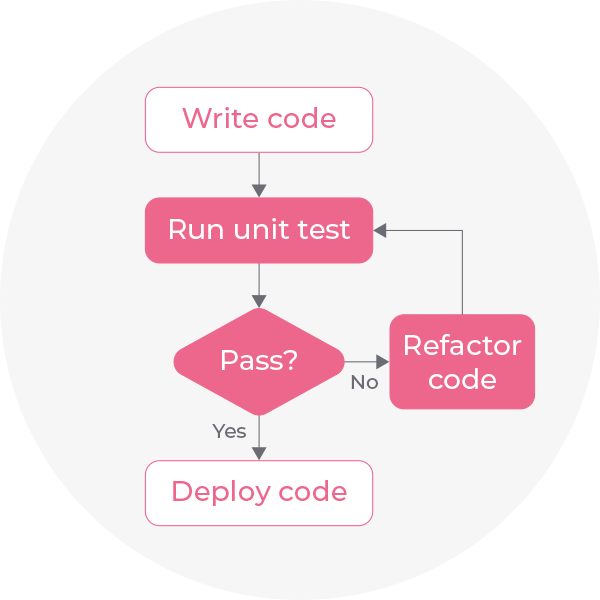
We’ve all experienced “clunky” websites that don’t work as they should. And we’ve all gone elsewhere because of it. Malfunctions from unexpected software bugs frustrate your customers and hamper your processes. As if that’s not enough, they can also take an excessive amount of IT resource to find and fix. That’s time (and money) you could be using on software development instead.
Nobody wants poor quality code inside their software.
That’s why we believe every project should have structured software testing embedded from day one. Before a single line of code is written. Whether it’s a website or a custom software product, you can succeed or falter due to your code.
In this article, we explain what unit testing is and why you should discuss it upfront with your software provider. We also highlight how testing helps your business over the software’s life – financially and operationally.


What is unit testing?
Unit testing ensures developers produce high quality code first time. And when your software product requires updates, unit testing helps future developers maintain the quality of your code.
A key part of the modern software landscape, you can define unit testing as:
The practice of testing individual units or components of software (pieces of code) before they’re implemented into the wider system.
Breaking software down into the smallest pieces, developers test each isolated function to ensure it behaves exactly as intended.
The result is a ‘pass’ or ‘fail’.
Using this process developers find errors and bugs before they’re embedded into the software system (and much harder to find).
Used consistently, unit testing creates more robust code. Future developments are less likely to ‘break’ your system too – the test pinpoints any fault instantly. They become a safety net. As developers make future changes, they’re confident of the results because unit tests highlight any problems upfront.
How does it help you?
It’s easy to see unit testing as an additional development cost. An upfront investment you can choose, or not. But think carefully. Yes, unit testing can add 10-30% to initial development costs, but over time, it pays off many times. And in countless ways.
Gain confidence
Embedding unit tests into your development process gives you confidence in two crucial ways:
- Confidence your software will perform exactly as intended
- Confidence you can change code in the future knowing everything will work
The financial and reputational implications of such confidence are huge.
Leave testing to your developers
When found early a bug is tiny. It’s a quick fix with no damage to your operations. But should you find it further down the line (because testing wasn’t in place) the stakes are much higher.
By having unit tests in place, you hand over much of the responsibility to your developers. It all but eliminates that tedious and time-consuming pre-launch task. Instead, your developers deliver robust software that works, now and in the future. It’s a more satisfying and productive way to work.
Financial savings
When unit testing adds to your development cost it might seem odd to suggest it can save you money. But it can.
Fixing bugs early takes little time. A thing of minutes sometimes. Yet, once the software has been built – even launched – it can take IT teams hours, days, or weeks to find and fix a malfunction.
Factor in higher customer service costs due to high call numbers, reduced sales due to high cart abandonment, and the market discussing your misfortune. It’s easy to see how costs can rack up.
Without unit tests in place, you can experience higher costs during software upgrades too. New developers create faults and have no idea why. Your hands feel tied and your development slows.
Unit testing saves you money during the life of your product. We’re confident of that.
Develop software faster
Stop this “two steps forward, one step back” business. With unit testing, developers thoroughly check every piece of code before it’s added. You keep moving forward, knowing it’s right.
In this way, you get more value from your development resources. Less head scratching and more “aha”. You get further, faster.
Unit tests also provide a practical form of documentation. It’s clear to everyone how each component should work. New team members get up to speed faster with clear instructions to refer to. It’s a win all round.

How unit testing works.
There are three stages to a unit test: planning and reviewing the test, writing test cases, and performing the test on the code.
This can be done manually or automatically. Automating the process is more effective as it flags failed tests and provides useful summaries.
As development grows, automated testing becomes more valuable. Finding and fixing bugs quickly frees up time to focus on other, more productive tasks. Later in the software life cycle automation is essential. Implementing software updates, patches, and building new requirements become more streamlined and error-free.

The Test Driven Development (TDD) approach.
Unit testing forms part of the Test Driven Development approach. Integration and acceptance tests are also part of the TDD logic.
When you boil it down, the idea of TDD is simple: you write your test code before you write your application code. That’s it.
Writing the test first helps to create better code. You must think about what you want your application to do and document that before writing the code.
TDD follows a cycle. The developer writes a failing test. They then write the smallest amount of code to pass the test. They can then refine (refactor) the code, ensuring it still passes the test.
It’s like creating a guidebook for your development. Developers plan your journey (write tests), querying anything that isn’t clear. They then follow the guide (write the code) before checking it’s in line with your intended journey (test the code).
In this systematic way, code only progresses when it’s passed the test and is bug-free.
Adopting a TDD approach ensures robust code that remains resilient over time. Your system operates as intended and you’re confident every line of code has been systematically tested.
TDD in action.
Here are two practical examples that show you how a Test Driven Development approach works.
#1 Building a user authentication system
The developer writes a test for the initial login functionality. This clarifies exactly what it must achieve. They then write the code for the login process and check to see if it passes the test. If it doesn’t, they refine the code and test again.
Once successful, they move on to create a test for the next phase: registration. Again, their code must pass the test before progressing to further functions such as password reset.
#2 Building an e-commerce website
The developer would first write a test for the product listing. After writing the code, it must pass the test before they move to the next stage: shopping cart functionality. Whenever code fails, they must refine it and ensure it passes before going forward.
Eventually, they create a bug-free e-commerce function. Integrated into the website, everyone is confident it will work as intended from day one.
Ask your potential suppliers the right questions about testing.
By understanding unit testing, you can have more effective conversations with future suppliers. You can specify the development process you wish to initiate with knowledge, understanding how the upfront testing investment will mitigate extra costs and risks over the product’s lifetime.
Ask your potential software providers what testing they embed into their development process. And ask them how they deliver bug-free code. Because the future reputation of your business depends on their response.
